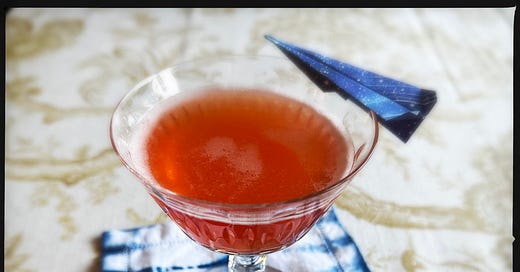Happier hours
It’s the long dark winter of our discontent; anyone else need a drink about now?
NOTE: This post was originally published on February 14, but I did something wrong and the email didn’t actually send, so here we are republishing it now. Two weeks ago, we were in the throes of sub-zero temps and dumping snow here in Iowa, and while winter isn’t quite so dark this week, there’s still plenty in the world that might put you in the mood for a drink. Or, hell, have one to celebrate that the sun does indeed still have some warmth for us. Cheers!
This is approximately the point in the stretch of a Midwestern winter when I’m pretty much constantly daydreaming of things like sand and palm trees and sunlight that emits actual warmth. We’ve recently been whomped with snow. The temps have been brutally frigid. The world is in a right state, and I think my body’s clock is also just set to crave an escape right around now.
If you’re in a similar mood and, like me, you’re not actually leaving on a jet plane anytime soon, perhaps I can interest you in a Paper Plane. The cocktail, that is.
I don’t remember where I first heard about the Paper Plane. I would have guessed it was through Imbibe magazine, but their online piece on the drink is dated 2017 and I know I’ve been making these since at least 2013.1 So, mystery unsolved.
However it arrived, I’m glad it landed here. This is a drink that works in any season. It’s perfectly sweet-tart and bright enough for summer, but the bourbon and amaro give it a warm core that stands up to winter, too.
Sam Ross and Sasha Petraske created the cocktail in 2008 as a “riff on the Last Word” — a description that is code for “Oma will like it.” The Paper Plane doesn’t actually share any of that drink’s ingredients, but it does follow the same equal parts formula of four components: a spirit, some sour citrus, something herbal or complex, and a sweet liqueur of some sort.
Anyway, enough talk, time to mix.
Hope this brings a little sunshine into your winter week. Cheers!
Paper Plane
Created by Sam Ross and Sasha Petraske for the summer menu at The Violet Hour
3/4 oz Bourbon
3/4 oz Aperol
3/4 oz Amaro Nonino
3/4 oz Lemon juice (I strain mine)
Shake to chill, and strain into a cocktail glass (I recommend double straining to catch any ice crystals, which interfere with the brightness of this drink for me). Garnish with a tiny paper airplane,2 because we are here to have fun, people, and because making things with your hands is good for you.
Notes: This is a wonderfully balanced drink, and I highly recommend you mix it as written, but you can make a couple of substitutions for necessity or taste.
Nonino is the preferred amaro,3 for example, but when I first started making these, I couldn’t get Nonino here, so I used Cardamaro and it worked fine. It’s also a lot cheaper.
And if you like things bitter (I do), you can sub Campari for the Aperol. In fact, that’s how Ross originally developed it, but then he had second thoughts about the levels of sweet/sour/bitter.
You could probably sub in a different whiskey, but I haven’t tried that, and I think the round, vanilla-sweetness of a good bourbon is a key part of the overall balance. If you do try something else here, let me know how it is!
How do I know that, you ask? Well, I remember it was already a favorite of mine when I recommended it to my niece-in-friendship as the bourbon-based option at her engagement party in 2016, and she confirms that I had actually first told her about it back in 2013. It’s a memorable drink, what can I say.
I am not an expert paper airplane folder, by any stretch, and I made the one shown following one of the most basic templates you can find. My secret to making it look cooler than it is: cool paper. I used a two-sided galaxy-patterned origami paper, cut into a small rectangle about 2x3” or maybe a little smaller. I also folded the back tips of the wings up to give it a tail, then snipped a little slit in the bottom to slip it over the rim of the glass.
Amaro is a bittersweet herbal liqueur, typically consumed after dinner as a digestif, as differentiated from the bittersweet liqueurs known as aperitifs (like Campari or Aperol), which are usually a little lower in alcohol and consumed before dinner to stimulate the appetite.





